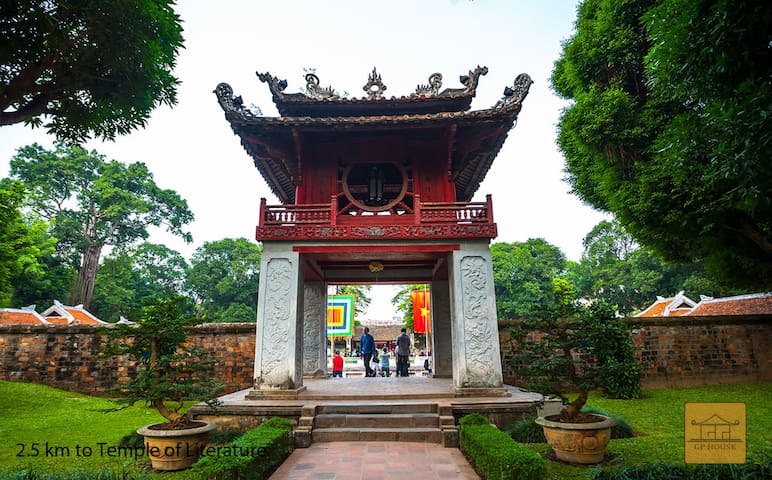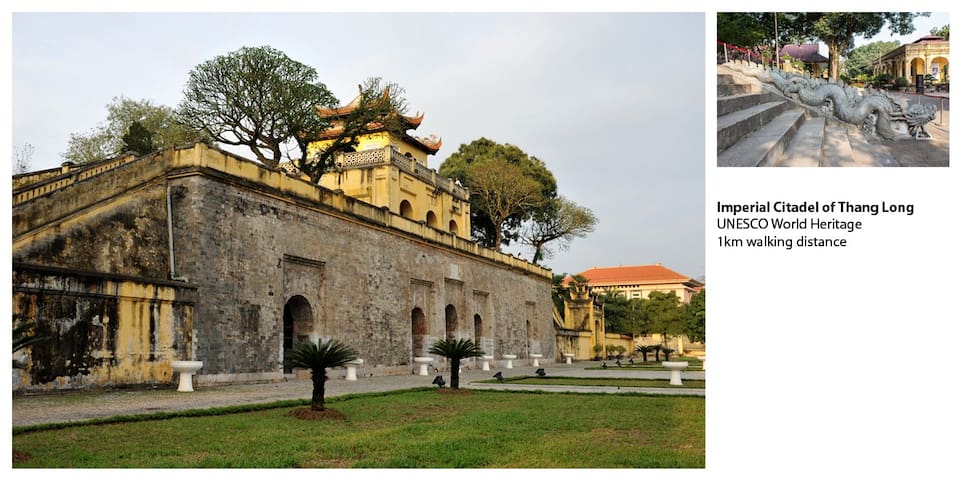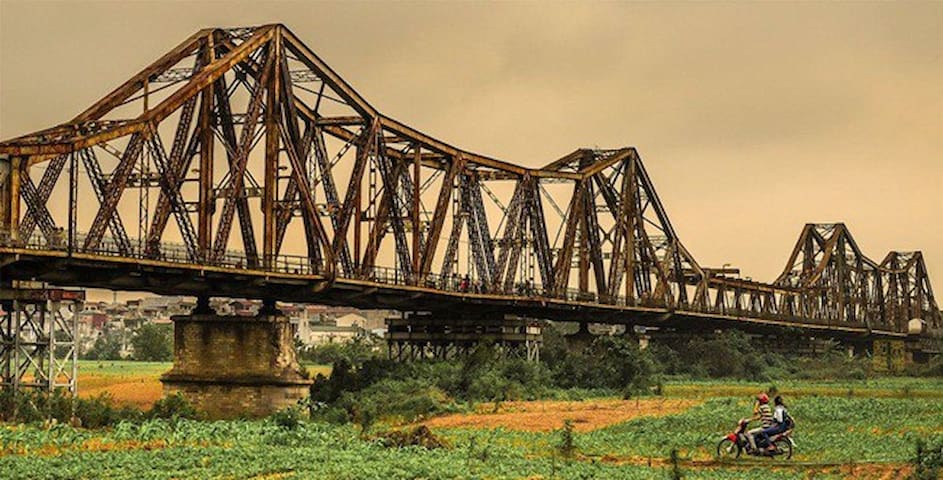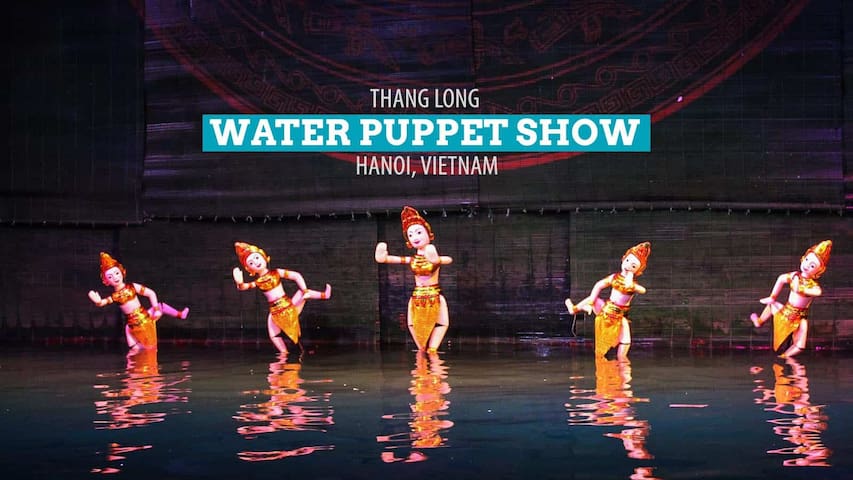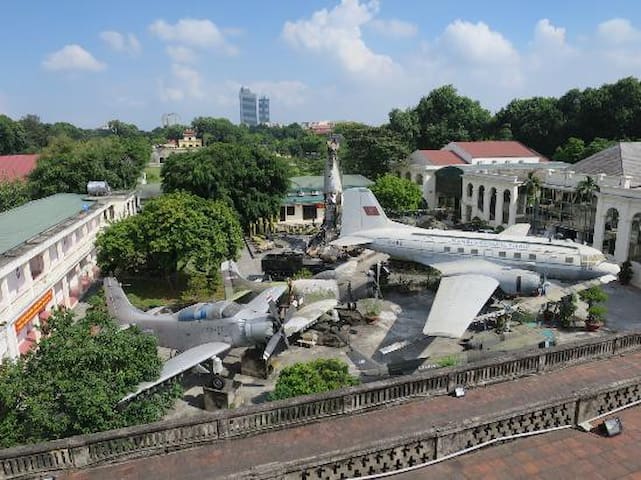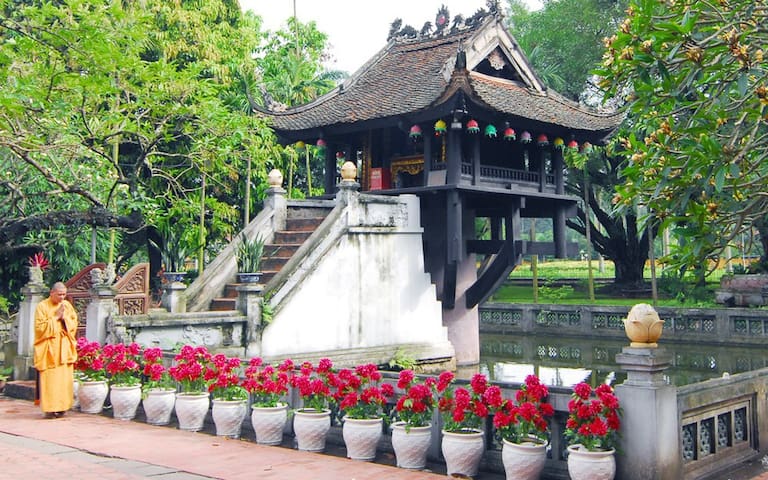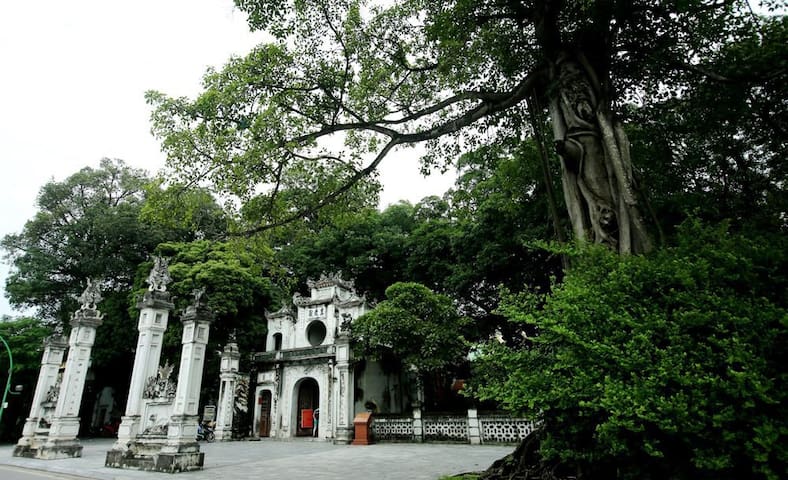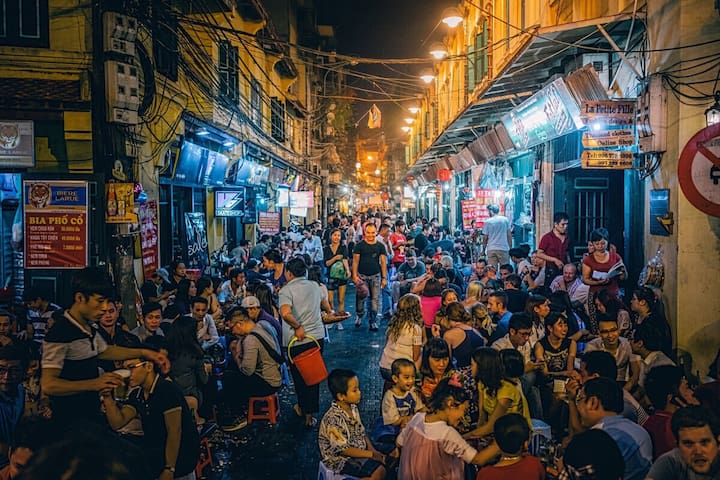Sightseeing
The Temple of Literature or Temple of Culture (Vietnamese: Văn Miếu, Hán-Nôm) is a Temple of Confucius in Hanoi, northern Vietnam. The temple hosts the Imperial Academy (Quốc Tử Giám), Vietnam's first national university. The temple was built in 1070 at the time of Emperor Lý Thánh Tông. It is one of several temples in Vietnam which is dedicated to Confucius, sages and scholars. The temple is located to the south of the Imperial Citadel of Thăng Long. The various pavilions, halls, statues and stelae of doctors are places where offering ceremonies, study sessions and the strict exams of the Đại Việt took place. The temple is featured on the back of the 100,000 Vietnamese đồng banknote. Just before the Vietnamese New Year celebration Tết, calligraphists will assemble outside the temple and write wishes in Hán characters. The art works are given away as gifts or are used as home decorations for special occasions.
246 preporuka/e lokalaca
Temple Of Literature
Temple of LiteratureThe Temple of Literature or Temple of Culture (Vietnamese: Văn Miếu, Hán-Nôm) is a Temple of Confucius in Hanoi, northern Vietnam. The temple hosts the Imperial Academy (Quốc Tử Giám), Vietnam's first national university. The temple was built in 1070 at the time of Emperor Lý Thánh Tông. It is one of several temples in Vietnam which is dedicated to Confucius, sages and scholars. The temple is located to the south of the Imperial Citadel of Thăng Long. The various pavilions, halls, statues and stelae of doctors are places where offering ceremonies, study sessions and the strict exams of the Đại Việt took place. The temple is featured on the back of the 100,000 Vietnamese đồng banknote. Just before the Vietnamese New Year celebration Tết, calligraphists will assemble outside the temple and write wishes in Hán characters. The art works are given away as gifts or are used as home decorations for special occasions.
The Imperial Citadel of Thăng Long (Vietnamese: Hoàng thành Thăng Long) is a complex of historic imperial buildings located in the centre of Hanoi, Vietnam. It is also known as Hanoi Citadel.
The royal enclosure was first built during the Lý dynasty (1010) and subsequently expanded by the Trần, Lê and finally the Nguyễn dynasty. It remained the seat of the Vietnamese court until 1810, when the Nguyễn dynasty chose to move the capital to Huế. The ruins roughly coincide with the Hanoi Citadel today.
The royal palaces and most of the structures in Thăng Long were in varying states of disrepair by the late 19th century with the upheaval of the French conquest of Hanoi. By the 20th century many of the remaining structures were torn down. Only in the 21st century are the ruin foundations of Thăng Long Imperial City systematically excavated.
In mid-1945 the Citadel was used by the Imperial Japanese Army to imprison over 4000 French colonial soldiers captured during the Japanese coup d'état in French Indochina in March 1945.[1]:19-20
The central sector of the imperial citadel was listed in UNESCO's World Heritage Site on July 31, 2010 at its session in Brazil, as "The Central Sector of the Imperial Citadel of Thăng Long – Hanoi"
114 preporuka/e lokalaca
Carska tvrđava Thang Long
19c Hoàng DiệuThe Imperial Citadel of Thăng Long (Vietnamese: Hoàng thành Thăng Long) is a complex of historic imperial buildings located in the centre of Hanoi, Vietnam. It is also known as Hanoi Citadel.
The royal enclosure was first built during the Lý dynasty (1010) and subsequently expanded by the Trần, Lê and finally the Nguyễn dynasty. It remained the seat of the Vietnamese court until 1810, when the Nguyễn dynasty chose to move the capital to Huế. The ruins roughly coincide with the Hanoi Citadel today.
The royal palaces and most of the structures in Thăng Long were in varying states of disrepair by the late 19th century with the upheaval of the French conquest of Hanoi. By the 20th century many of the remaining structures were torn down. Only in the 21st century are the ruin foundations of Thăng Long Imperial City systematically excavated.
In mid-1945 the Citadel was used by the Imperial Japanese Army to imprison over 4000 French colonial soldiers captured during the Japanese coup d'état in French Indochina in March 1945.[1]:19-20
The central sector of the imperial citadel was listed in UNESCO's World Heritage Site on July 31, 2010 at its session in Brazil, as "The Central Sector of the Imperial Citadel of Thăng Long – Hanoi"
West Lake
D8, 14 Thụy KhuêThe bridge was built in 1899-1902 by the architects Daydé & Pillé of Paris, and opened in 1903.[1] Before North Vietnam's independence in 1954, it was called Paul-Doumer Bridge, named after Paul Doumer - The Governor-General of French Indochina and then French president. At 2.4 kilometres (1.5 mi) in length,[1] it was, at that time, one of the longest bridges in Asia. For the French colonial government, the construction was of strategic importance in securing control of northern Vietnam. From 1899 to 1902, more than 3,000 Vietnamese took part in the construction.
It was heavily bombarded during Vietnam War due to its critical position (the only bridge at that time across the Red River connecting Hanoi to the main port of Haiphong). The first attack took place in 1967, and the center span of the bridge was felled by an attack by 20 USAF F-105 fighter-bombers.[2] CIA reports noted that the severing of the bridge did not appear to have caused as much disruption as had been expected.[3] The defence of Long Bien Bridge continues to play a large role in Hanoi’s self-image and is often extolled in poetry and song. It was rendered unusable for a year when, in May 1972, it fell victim to one of the first co-ordinated attacks using laser-guided "smart bombs"
85 preporuka/e lokalaca
Long Bien Bridge
The bridge was built in 1899-1902 by the architects Daydé & Pillé of Paris, and opened in 1903.[1] Before North Vietnam's independence in 1954, it was called Paul-Doumer Bridge, named after Paul Doumer - The Governor-General of French Indochina and then French president. At 2.4 kilometres (1.5 mi) in length,[1] it was, at that time, one of the longest bridges in Asia. For the French colonial government, the construction was of strategic importance in securing control of northern Vietnam. From 1899 to 1902, more than 3,000 Vietnamese took part in the construction.
It was heavily bombarded during Vietnam War due to its critical position (the only bridge at that time across the Red River connecting Hanoi to the main port of Haiphong). The first attack took place in 1967, and the center span of the bridge was felled by an attack by 20 USAF F-105 fighter-bombers.[2] CIA reports noted that the severing of the bridge did not appear to have caused as much disruption as had been expected.[3] The defence of Long Bien Bridge continues to play a large role in Hanoi’s self-image and is often extolled in poetry and song. It was rendered unusable for a year when, in May 1972, it fell victim to one of the first co-ordinated attacks using laser-guided "smart bombs"
According to the legend, in early 1428, Emperor Lê Lợi was boating on the lake when a Golden Turtle God (Kim Qui) surfaced and asked for his magic sword, Heaven's Will. Lợi concluded that Kim Qui had come to reclaim the sword that its master, a local God, the Dragon King (Long Vương) had given Lợi some time earlier, during his revolt against Ming China. Later, the Emperor gave the sword back to the turtle after he finished fighting off the Chinese. Emperor Lợi renamed the lake to commemorate this event, from its former name Luc Thuy meaning "Green Water". The Turtle Tower (Tháp Rùa) standing on a small island near the centre of lake is linked to the legend. The first name of Hoàn Kiếm lake is Tả Vọng, when the King hadn't given the Magical Sword back to the Golden Turtle God (Cụ Rùa).
513 preporuka/e lokalaca
Jezero Hoan Kiem
According to the legend, in early 1428, Emperor Lê Lợi was boating on the lake when a Golden Turtle God (Kim Qui) surfaced and asked for his magic sword, Heaven's Will. Lợi concluded that Kim Qui had come to reclaim the sword that its master, a local God, the Dragon King (Long Vương) had given Lợi some time earlier, during his revolt against Ming China. Later, the Emperor gave the sword back to the turtle after he finished fighting off the Chinese. Emperor Lợi renamed the lake to commemorate this event, from its former name Luc Thuy meaning "Green Water". The Turtle Tower (Tháp Rùa) standing on a small island near the centre of lake is linked to the legend. The first name of Hoàn Kiếm lake is Tả Vọng, when the King hadn't given the Magical Sword back to the Golden Turtle God (Cụ Rùa).
Water puppetry (Vietnamese: Múa rối nước, lit. "Making puppets dance on water") is a tradition that dates back as far as the 11th century when it originated in the villages of the Red River Delta area of northern Vietnam. Today's Vietnamese water puppetry is a unique variation on the ancient Asian puppet tradition.
The puppets are made out of wood and then lacquered. The shows are performed in a waist-deep pool. A large bamboo rod supports the puppet under the water and is used by the puppeteers, who are normally hidden behind a screen, to control them. Thus the puppets appear to be moving over the water. When the rice fields would flood, the villagers would entertain each other using this form of puppet play.
207 preporuka/e lokalaca
Thang Long kazalište vodenih lutaka
57B Đinh Tiên HoàngWater puppetry (Vietnamese: Múa rối nước, lit. "Making puppets dance on water") is a tradition that dates back as far as the 11th century when it originated in the villages of the Red River Delta area of northern Vietnam. Today's Vietnamese water puppetry is a unique variation on the ancient Asian puppet tradition.
The puppets are made out of wood and then lacquered. The shows are performed in a waist-deep pool. A large bamboo rod supports the puppet under the water and is used by the puppeteers, who are normally hidden behind a screen, to control them. Thus the puppets appear to be moving over the water. When the rice fields would flood, the villagers would entertain each other using this form of puppet play.
The Viet Nam Military History Museum, set up on 17 July 1956, is one of seven national museums in Vietnam. It covers 12,800 m2. It is situated in central Hanoi, opposite the Lenin Park and near the Ho Chi Minh Mausoleum. The Flag Tower of Hanoi is located inside of the museum grounds.
28A Dien Bien Phu Road, Ba Dinh district, HaNoi, Phone (+84-4) - 38234264
Entrance is 40,000 VND, 30,000 for cameras.
Museum is currently not open on Monday and Friday and closes for lunch between 11:30 and 13:00
Opening Hours 8h00 - 11h30 and 13h00 - 16h00
66 preporuka/e lokalaca
Vojni muzej Vijetnama
28A Điện Biên PhủThe Viet Nam Military History Museum, set up on 17 July 1956, is one of seven national museums in Vietnam. It covers 12,800 m2. It is situated in central Hanoi, opposite the Lenin Park and near the Ho Chi Minh Mausoleum. The Flag Tower of Hanoi is located inside of the museum grounds.
28A Dien Bien Phu Road, Ba Dinh district, HaNoi, Phone (+84-4) - 38234264
Entrance is 40,000 VND, 30,000 for cameras.
Museum is currently not open on Monday and Friday and closes for lunch between 11:30 and 13:00
Opening Hours 8h00 - 11h30 and 13h00 - 16h00
Amuseum in Hanoi, Vietnam, which focuses on the 54 officially recognised ethnic groups in Vietnam. It is located on a 43,799-square-metre (10.823-acre) property in the Cầu Giấy District, about 8 km from the city center. The Museum is a member of the Vietnam Academy of Social Sciences - an academic institution of the Vietnamese Government.
147 preporuka/e lokalaca
Muzej etnologije Vijetnama
Đường Nguyễn Văn HuyênAmuseum in Hanoi, Vietnam, which focuses on the 54 officially recognised ethnic groups in Vietnam. It is located on a 43,799-square-metre (10.823-acre) property in the Cầu Giấy District, about 8 km from the city center. The Museum is a member of the Vietnam Academy of Social Sciences - an academic institution of the Vietnamese Government.
The One Pillar Pagoda (Vietnamese: Chùa Một Cột) is a historic Buddhist temple in Hanoi, the capital of Vietnam. It is regarded alongside the Perfume Temple, as one of Vietnam's two most iconic temples.
The temple was built by Emperor Lý Thái Tông, who ruled from 1028 to 1054. According to the court records, Lý Thái Tông was childless and dreamt that he met the bodhisattva Avalokiteshvara, who handed him a baby son while seated on a lotus flower. Lý Thái Tông then married a peasant girl that he had met and she bore him a son. The emperor constructed the temple in gratitude for this in 1049, having been told by a monk named Thiền Tuệ to build the temple, by erecting a pillar in the middle of a lotus pond, similar to the one he saw in the dream.
88 preporuka/e lokalaca
Pagoda Jednog Stupa
phố Chùa Một CộtThe One Pillar Pagoda (Vietnamese: Chùa Một Cột) is a historic Buddhist temple in Hanoi, the capital of Vietnam. It is regarded alongside the Perfume Temple, as one of Vietnam's two most iconic temples.
The temple was built by Emperor Lý Thái Tông, who ruled from 1028 to 1054. According to the court records, Lý Thái Tông was childless and dreamt that he met the bodhisattva Avalokiteshvara, who handed him a baby son while seated on a lotus flower. Lý Thái Tông then married a peasant girl that he had met and she bore him a son. The emperor constructed the temple in gratitude for this in 1049, having been told by a monk named Thiền Tuệ to build the temple, by erecting a pillar in the middle of a lotus pond, similar to the one he saw in the dream.
Legend has it that Quán Thánh Temple was established during the reign of Emperor Lý Thái Tổ (reigned 1010–1028) and was dedicated to Trấn Vũ, Deity of the North in Taoism, whose symbols of power are the serpent and turtle (see section on Animal Symbolism below).[1] It is one of the Four Sacred Temples that were built in four directions to protect the capital from malevolent spirits. Quán Thánh protects from the North, while the other three temples protect from the other directions: Bạch Mã from the East, Kim Liêm from the South, and Thần Linh Lang from the West.[2] In Hanoi, there is also a second Trấn Vũ Temple in the Gia Lâm District. Though smaller than Quán Thánh Temple, this smaller temple is also dedicated to Trấn Vũ with a 9-tonne statue of the deity.
Nowadays, after many geographical changes to the city layout, Quán Thánh Temple is located on the corner of Quán Thánh Street and Thanh Nien Street, facing West Lake. It is a short walk from Trúc Bạch Lake where pilot (and future United States senator) John McCain was shot down in October 1967.[3]
30 preporuka/e lokalaca
Hram Quan Thanh
Đường Thanh NiênLegend has it that Quán Thánh Temple was established during the reign of Emperor Lý Thái Tổ (reigned 1010–1028) and was dedicated to Trấn Vũ, Deity of the North in Taoism, whose symbols of power are the serpent and turtle (see section on Animal Symbolism below).[1] It is one of the Four Sacred Temples that were built in four directions to protect the capital from malevolent spirits. Quán Thánh protects from the North, while the other three temples protect from the other directions: Bạch Mã from the East, Kim Liêm from the South, and Thần Linh Lang from the West.[2] In Hanoi, there is also a second Trấn Vũ Temple in the Gia Lâm District. Though smaller than Quán Thánh Temple, this smaller temple is also dedicated to Trấn Vũ with a 9-tonne statue of the deity.
Nowadays, after many geographical changes to the city layout, Quán Thánh Temple is located on the corner of Quán Thánh Street and Thanh Nien Street, facing West Lake. It is a short walk from Trúc Bạch Lake where pilot (and future United States senator) John McCain was shot down in October 1967.[3]
Food scene
Stari grad
Phố Lương Ngọc Quyến
